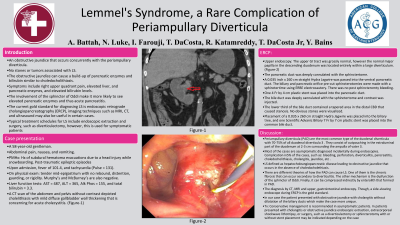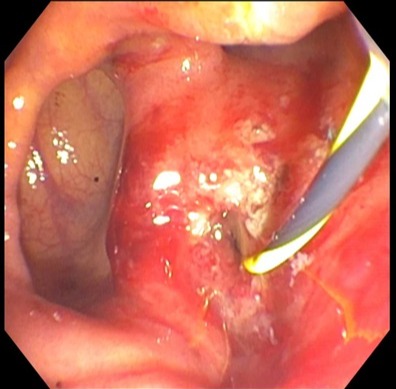Back


Poster Session B - Monday Morning
Category: Biliary/Pancreas
B0055 - Lemmel's Syndrome, a Rare Complication of Periampullary Diverticula
Monday, October 24, 2022
10:00 AM – 12:00 PM ET
Location: Crown Ballroom

Has Audio

Arwa Battah, MD
Saint Michael's Medical Center
Newark, NJ
Presenting Author(s)
Arwa Battah, MD1, Nicholas Luke, 2, Iyad Farouji, MD1, Theodore DaCosta, MD, DO1, Rewanth Katamreddy, MD1, Theodore DaCosta, MD, DO3, Yatinder Bains, MD3
1Saint Michael's Medical Center, Newark, NJ; 2Saint Georges University, Newark, NJ; 3Saint Michael's Medical Center, New York Medical College, Newark, NJ
Introduction: Lemmel’s Syndrome (LS) is obstructive jaundice that occurs concurrently with the periampullary diverticula. Obstructive jaundice can cause a build-up of pancreatic enzymes and bilirubin similar to choledocholithiasis. Typically there will be extrahepatic and intrahepatic dilation of the bile ducts.
Case Description/Methods: A 58-year-old gentelman presents to the emergency department with abdominal pain, nausea, and vomiting. Upon admission, he developed a fever of 101.4 F, and tachycardia (Pulse = 131 BPM). On physical exam, he had a tender mid-epigastrium with no rebound, distention, guarding, or rigidity. Liver function tests were elevated: AST = 487U/L (normal range: 10-36 U/L), ALT = 365 U/L (normal range: 9-46 U/L), ALP = 155 U/L (40-115 U/L), and total bilirubin= 3.9 mg/dl (normal range: 0.6-1.2 mg/dl) with direct bilirubin of: 3.2 mg/dl (normal range: 0.0-0.3 mg/dl). An US of the right upper quadrant revealed normal size biliary ducts. CT scan revealed a diverticulum in the second part of the duodenum, with no dilation in the extra/intrahepatic ducts. He was started on antibiotics and fluids as per sepsis protocol and then underwent ERCP. The upper GI tract was normal, however, the normal major papilla in the descending duodenum was located entirely within a large diverticulum (image-1). The pancreatic duct was deeply cannulated with the sphinctertomy and a stent was placed. In the following two days, he improved dramatically.
Discussion: Periampullary diverticula (PAD) are the most common type of the duodenal diverticula with 70-75% of all duodenal diverticula. They consist of outpouching in the extraluminal part of the duodenum at 2-3 cm surrounding the ampulla of vater. Most of the cases are asymptomatic and diagnosed incidentally during endoscopies, though there is a wide range of complications. LS is defined as hepatocholeangiopancreatic disease leading to obstructive jaundice in the absence of choledocholithiasis. The diagnosis of the LS is challenging. Many modalities can be used including CT, MRI, and upper gastrointestinal endoscopy. Though, a side-viewing endoscope during ERCP is the gold standard in diagnosing PAD. On imaging, it will appear as thin-walled cavitary lesions located on the medial wall of the second portion of the duodenum with extrahepatic and intrahepatic biliary ducts dilatation. In our case, the patient presented with obstructive jaundice with cholangitis without dilatation of the biliary ducts which makes the case more unique.

Disclosures:
Arwa Battah, MD1, Nicholas Luke, 2, Iyad Farouji, MD1, Theodore DaCosta, MD, DO1, Rewanth Katamreddy, MD1, Theodore DaCosta, MD, DO3, Yatinder Bains, MD3. B0055 - Lemmel's Syndrome, a Rare Complication of Periampullary Diverticula, ACG 2022 Annual Scientific Meeting Abstracts. Charlotte, NC: American College of Gastroenterology.
1Saint Michael's Medical Center, Newark, NJ; 2Saint Georges University, Newark, NJ; 3Saint Michael's Medical Center, New York Medical College, Newark, NJ
Introduction: Lemmel’s Syndrome (LS) is obstructive jaundice that occurs concurrently with the periampullary diverticula. Obstructive jaundice can cause a build-up of pancreatic enzymes and bilirubin similar to choledocholithiasis. Typically there will be extrahepatic and intrahepatic dilation of the bile ducts.
Case Description/Methods: A 58-year-old gentelman presents to the emergency department with abdominal pain, nausea, and vomiting. Upon admission, he developed a fever of 101.4 F, and tachycardia (Pulse = 131 BPM). On physical exam, he had a tender mid-epigastrium with no rebound, distention, guarding, or rigidity. Liver function tests were elevated: AST = 487U/L (normal range: 10-36 U/L), ALT = 365 U/L (normal range: 9-46 U/L), ALP = 155 U/L (40-115 U/L), and total bilirubin= 3.9 mg/dl (normal range: 0.6-1.2 mg/dl) with direct bilirubin of: 3.2 mg/dl (normal range: 0.0-0.3 mg/dl). An US of the right upper quadrant revealed normal size biliary ducts. CT scan revealed a diverticulum in the second part of the duodenum, with no dilation in the extra/intrahepatic ducts. He was started on antibiotics and fluids as per sepsis protocol and then underwent ERCP. The upper GI tract was normal, however, the normal major papilla in the descending duodenum was located entirely within a large diverticulum (image-1). The pancreatic duct was deeply cannulated with the sphinctertomy and a stent was placed. In the following two days, he improved dramatically.
Discussion: Periampullary diverticula (PAD) are the most common type of the duodenal diverticula with 70-75% of all duodenal diverticula. They consist of outpouching in the extraluminal part of the duodenum at 2-3 cm surrounding the ampulla of vater. Most of the cases are asymptomatic and diagnosed incidentally during endoscopies, though there is a wide range of complications. LS is defined as hepatocholeangiopancreatic disease leading to obstructive jaundice in the absence of choledocholithiasis. The diagnosis of the LS is challenging. Many modalities can be used including CT, MRI, and upper gastrointestinal endoscopy. Though, a side-viewing endoscope during ERCP is the gold standard in diagnosing PAD. On imaging, it will appear as thin-walled cavitary lesions located on the medial wall of the second portion of the duodenum with extrahepatic and intrahepatic biliary ducts dilatation. In our case, the patient presented with obstructive jaundice with cholangitis without dilatation of the biliary ducts which makes the case more unique.

Figure: ERCP revealed: ERCP normal upper GI tract, however the normal major papilla in the descending duodenum was located entirely within a large diverticulum
Disclosures:
Arwa Battah indicated no relevant financial relationships.
Nicholas Luke indicated no relevant financial relationships.
Iyad Farouji indicated no relevant financial relationships.
Theodore DaCosta indicated no relevant financial relationships.
Rewanth Katamreddy indicated no relevant financial relationships.
Theodore DaCosta indicated no relevant financial relationships.
Yatinder Bains indicated no relevant financial relationships.
Arwa Battah, MD1, Nicholas Luke, 2, Iyad Farouji, MD1, Theodore DaCosta, MD, DO1, Rewanth Katamreddy, MD1, Theodore DaCosta, MD, DO3, Yatinder Bains, MD3. B0055 - Lemmel's Syndrome, a Rare Complication of Periampullary Diverticula, ACG 2022 Annual Scientific Meeting Abstracts. Charlotte, NC: American College of Gastroenterology.
